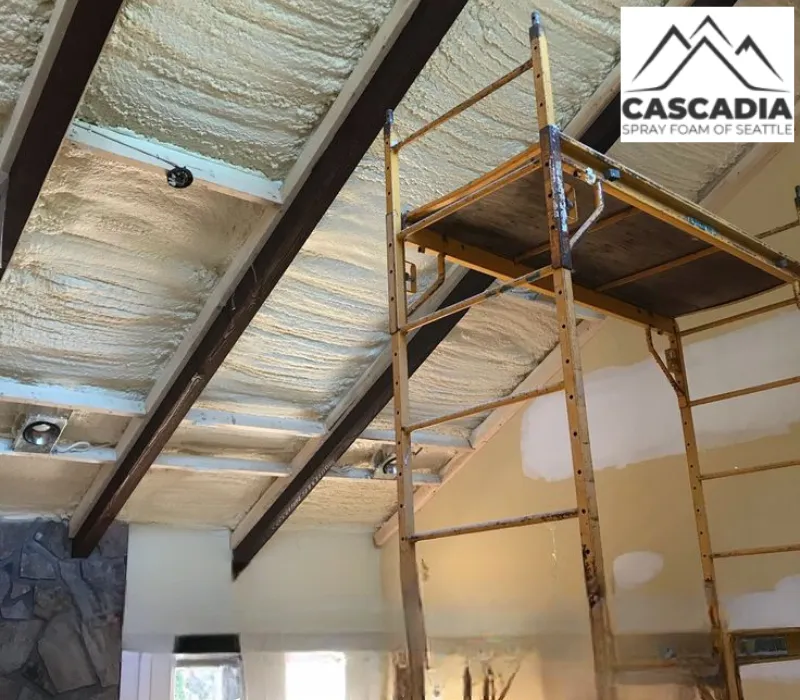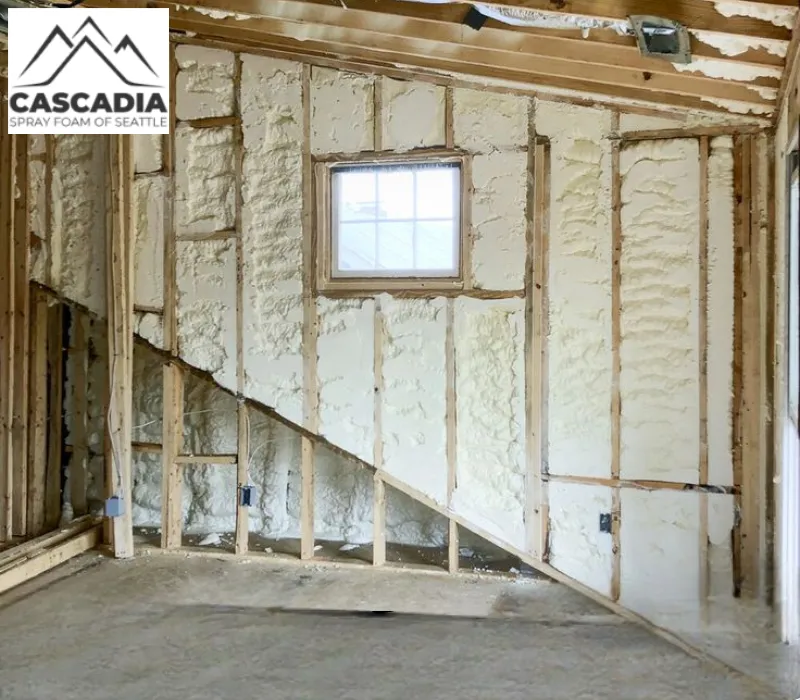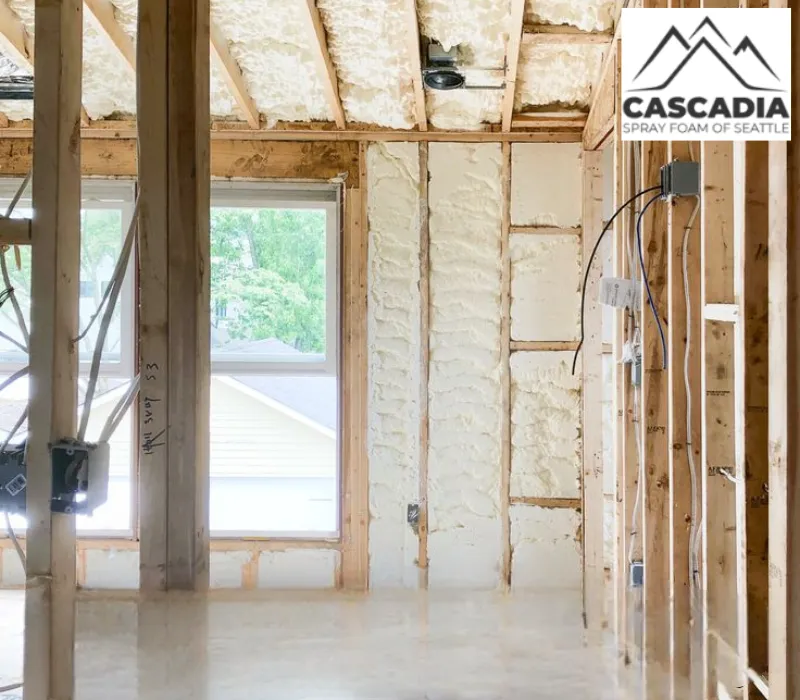
You’re probably feeling the pinch from rising energy bills or drafts sneaking through your home’s walls. Insulation plays a big role in keeping your space comfortable year-round, and spray foam stands out as a smart choice for tackling those issues head-on. This guide covers everything you need to know about spray foam insulation, from its basics to how it saves money over time.
Spray foam insulation is a versatile material that expands to fill gaps and create an airtight seal. It comes from mixing two chemicals that react on site to form a foam, which then hardens into a solid barrier. Unlike traditional options like fiberglass batts or cellulose, spray foam adheres directly to surfaces and offers superior performance in sealing air leaks. This makes it ideal for homes, buildings, and even industrial spaces where energy efficiency matters most.
Given its advantages, why focus on spray foam now? With homes accounting for nearly 40% of U.S. energy use, better insulation reduces heating and cooling costs while cutting carbon emissions. A report from the U.S. Department of Energy highlights how proper insulation can lower utility bills by up to 20%. Plus, as building codes tighten and sustainability becomes a priority, spray foam’s durability and eco-friendly potential position it as a forward-thinking solution.
This guide draws from years of hands-on work installing spray foam in Seattle’s varied climate, where moisture and temperature swings test any material’s limits. You’ll get a clear path through the topic: start with the fundamentals, explore benefits and types, dive into applications and installation, break down costs, address challenges, and look at future developments. By the end, you’ll have the knowledge to decide if spray foam fits your needs and how to make it work for you.
Spray foam insulation starts as a liquid mixture of polyols and isocyanates. Technicians mix and spray it onto surfaces using specialized equipment. The mixture expands rapidly—up to 100 times its liquid volume—before curing into a foam that fills cracks, crevices, and voids.
There are two main categories: open-cell and closed-cell foams. Open-cell has tiny, interconnected air pockets that make it lighter and more flexible. Closed-cell, on the other hand, features sealed cells packed with gas, giving it higher density and moisture resistance. Both types create thermal barriers, but they behave differently under various conditions.
The process relies on a chemical reaction called polymerization. Once applied, the foam bonds to wood, metal, concrete, or drywall, forming a seamless layer. This adhesion prevents settling or sagging over time, a common issue with loose-fill insulations. In practice, it blocks heat transfer through conduction, convection, and air infiltration, keeping indoor temperatures stable.
You might wonder about safety during application. Professionals use protective gear to handle the chemicals, and the foam off-gasses minimally after curing. Ventilation ensures a safe environment, and cured foam meets strict indoor air quality standards set by organizations like the EPA.
Expert Tip: Always check your local building codes before starting any insulation project. They often specify R-value requirements, which measure the foam’s resistance to heat flow.
One of the biggest advantages is its energy efficiency. Spray foam’s high R-value—typically R-3.5 to R-7 per inch—means thinner layers provide the same protection as thicker traditional materials. This saves space in walls or attics while maximizing performance.
Air sealing takes it further. Traditional insulations leave gaps where air leaks out, but spray foam expands to seal them completely. According to the Insulation Institute, this can reduce air leakage by up to 24% in a typical home, directly lowering energy use.
Moisture control adds another layer of protection. Closed-cell foam acts as a vapor barrier, resisting water intrusion in humid areas like basements, as detailed in the types section. This helps prevent mold growth and structural damage, especially in rainy climates like the Pacific Northwest.
Noise reduction is a bonus many overlook. The foam dampens sound transmission, creating quieter interiors. In multi-family buildings, this improves livability without extra soundproofing layers.
Durability ensures long-term value. Spray foam lasts 25 years or more without degrading, resisting pests like rodents that chew through other materials. Its rigid structure also adds minor structural support to roofs or walls.
From an environmental standpoint, while production uses chemicals, the energy savings offset the footprint. A study by Oak Ridge National Laboratory found that homes with spray foam use 15-20% less energy annually compared to those with fiberglass.
Market data backs this up: The global spray foam market reached $2.4 billion in 2022, driven by demand for green building materials, as reported by Grand View Research.
You’ll notice comfort improvements right away—no more cold spots or uneven heating. These benefits compound over time, making spray foam a solid investment for homeowners and builders alike.
Key Takeaways:
Choosing between open-cell and closed-cell depends on your specific needs, climate, and budget. Let’s compare them directly.
Open-cell spray foam weighs about 0.5 pounds per cubic foot and provides an R-value of around 3.6 per inch. It’s breathable, allowing moisture to pass through, which suits dry regions. Sound absorption is excellent, making it popular for interior walls.
Closed-cell spray foam is denser at 2 pounds per cubic foot, with an R-value up to 7 per inch. It repels water and adds rigidity, ideal for below-grade applications or coastal areas prone to flooding. However, it’s less flexible and costs more upfront.
Here’s a quick comparison table:
| Feature | Open-Cell | Closed-Cell |
|---|---|---|
| R-Value per Inch | 3.5-3.8 | 6.0-7.0 |
| Density (lbs/ft³) | 0.4-0.8 | 1.7-2.3 |
| Moisture Resistance | Moderate (vapor permeable) | High (vapor retarder) |
| Cost per Board Foot | $0.25-$0.50 | $0.75-$1.50 |
| Best For | Interiors, soundproofing | Exteriors, structural |
Both require professional installation due to the equipment involved, but open-cell is easier to apply in tight spaces.
Pros of open-cell include affordability and flexibility; it expands more, filling irregular shapes without damage. Cons: Lower R-value means thicker applications for the same insulation level, and it doesn’t handle high humidity well.
Closed-cell shines in wet environments and provides better thermal performance per inch. Drawbacks: Higher cost and rigidity that might crack in settling structures.

Spray foam adapts to various settings, from residential to commercial projects. In homes, it’s commonly used in attics to prevent heat escape, walls to seal gaps around windows, and crawl spaces to block ground moisture.
For new construction, builders apply it during framing to create energy-efficient envelopes from the start. Retrofitting older homes benefits too—think injecting foam into existing walls without major demolition.
Commercial buildings use it for roofs and floors to meet large-scale energy codes. Warehouses gain from its ability to insulate irregularly shaped spaces, like around ducts or pipes.
In Seattle’s mild but wet weather, closed-cell foam protects against dampness in basements, while open-cell suits interior partitions for better acoustics in offices.
Industrial applications include insulating tanks or refrigeration units, where thermal control prevents spoilage or inefficiency.
Expert Tip: In attics, combine spray foam with ventilation systems to avoid trapping moisture that could lead to condensation issues.
Installing spray foam requires trained pros, but understanding the steps helps you prepare.
First, prepare the site: Clear the area, cover floors and vents with plastic sheeting, and ensure good airflow. Inspect for hazards like electrical wiring that needs protection.
Next, set up equipment: The spray rig includes tanks for the two components, hoses, and a spray gun. Technicians calibrate pressure and temperature for optimal mix—too cold, and it won’t expand right.
Apply in layers: Start from the bottom or farthest point, spraying in passes of 2-4 inches. The foam expands in seconds, so work quickly. For walls, fill cavities fully; for attics, create a uniform layer over joists.
Cure time varies—open-cell sets in minutes, closed-cell in hours. Trim excess once firm, then test for coverage with a thermal camera if possible.
Post-installation, ventilate for 24-48 hours to dissipate any odors. Follow up with air quality checks if sensitive occupants are present.
Safety note: Never attempt DIY with rental kits; inconsistent mixing can release harmful fumes or underperform.
Upfront costs for spray foam range from $1 to $3 per square foot installed, higher than fiberglass at $0.50-$1.50. But factor in performance: Its efficiency means smaller HVAC systems, saving on equipment too.
Break down a typical 1,500 sq ft home retrofit:
| Area | Sq Ft | Cost per Sq Ft | Total Cost |
|---|---|---|---|
| Attic (open-cell) | 1,000 | $1.00 | $1,000 |
| Walls (closed-cell) | 1,200 | $2.00 | $2,400 |
| Rim Joists | 300 | $1.50 | $450 |
| Total | $3,850 |
Over 10 years, energy savings of $500 annually recoup the investment. The National Insulation Association estimates payback in 4-7 years, with 20-30% ongoing reductions.
Market stat: U.S. residential insulation spending hit $10 billion in 2023, with spray foam growing 8% yearly per Statista.
Other factors: Rebates from utilities or tax credits like the Inflation Reduction Act can cut 30% off costs. Long-term, it boosts home value—insulated homes sell 5-10% faster.
Key Takeaways:
Expert Tip: Get multiple quotes and ask about warranties—reputable installers offer 20-25 year coverage on the foam itself.
One challenge is off-gassing during install, but proper ventilation minimizes it. Choose low-VOC foams certified by GREENGUARD for sensitive spaces.
Moisture in walls can cause expansion issues if not addressed pre-application. Dry out damp areas first and use dehumidifiers if needed.
Over-spraying leads to waste; skilled techs avoid this by practicing on test boards. In tight spots, smaller rigs help precision.
Health concerns: While safe when cured, avoid direct contact during application. Post-install, air out the space before reoccupying.
For cold climates, ensure foam doesn’t freeze mid-application—warm materials to 70-80°F. In hot weather, shade equipment to prevent premature curing.
Addressing these keeps projects smooth and effective.
Track ROI by monitoring energy bills pre- and post-install. Use tools like home energy audits to quantify improvements.
Calculate simple ROI: (Annual Savings – Maintenance Costs) / Initial Investment x 100. With $500 savings and $4,000 cost, that’s 12.5% yearly return.
Long-term, spray foam maintains R-value without compression, unlike batts that settle 20% over time. This consistent performance ensures steady savings.
Pair with smart thermostats for amplified results—up to 230 hours of comfort per degree adjustment, per Energy Star.
Annual inspections spot issues early, preserving efficiency.
Bio-based foams incorporate plant oils, reducing petroleum use by 20-60%, as noted in research from the Polyurethane Foam Association.
Advancements in spray equipment allow for variable density, customizing on-site for different needs. This lowers waste and improves adaptability in retrofits.
Smart foams with embedded sensors could monitor performance in real-time, alerting to degradation. Early prototypes show promise for commercial use.
Sustainability pushes: Recyclable variants and lower-GWP blowing agents address environmental concerns. Market growth is projected at 6% CAGR through 2030.
These changes make spray foam even more accessible and green.
Expert Tip: Stay updated on rebates—programs like ENERGY STAR often expand to cover new tech.
To address common queries based on the above information:

Yes, once cured, spray foam is inert and doesn’t release particles or fibers like fiberglass. Opt for low-VOC options tested by third-party labs to ensure minimal emissions. Professionals ventilate during and after install to clear any temporary odors.
It typically lasts 25-80 years, depending on type and conditions. Closed-cell holds up best in harsh environments, while proper installation prevents most degradation over decades.
DIY kits exist for small jobs, but full projects require pros due to equipment and safety. Inconsistent application can void warranties or create health risks from poor mixing.
It deters rodents and insects by sealing entry points and lacking appeal as nesting material. No food source or easy chewability keeps pests away better than open insulations.
Open-cell runs $0.25-$0.50 per board foot; closed-cell $0.75-$1.50. The price gap reflects density and added properties, but closed-cell often pays off faster in moist areas.
Not if balanced with proper ventilation. It seals leaks, but mechanical systems like HRVs ensure fresh air flow, preventing stuffiness or moisture buildup.
You’ve now got a full picture of spray foam insulation—its workings, advantages, types, uses, setup, costs, hurdles, and what’s ahead. The main points: It delivers top energy savings, seals air tightly, and lasts for decades, often paying for itself in under seven years. Use this as your reference to evaluate options, get quotes, and plan upgrades. Start small if needed, like an attic project, and build from there to create a more efficient, comfortable space.
Ready to explore spray foam for your property? Cascadia Spray Foam of Seattle offers consultations tailored to Seattle’s unique climate. Reach out at [email protected] or call (425) 386-3500 to discuss your needs and get a free estimate. Their team brings local expertise to ensure lasting results without the hassle.